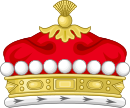| Viscountcy of Devonport | |
|---|---|
  Azure in chief two Mitres Argent garnished Or and in base a Square Tower of the second | |
| Creation date | 22 Jun 1917 |
| Created by | King George V |
| Peerage | Peerage of the United Kingdom |
| First holder | Hudson Ewbanke Kearley, 1st Viscount Devonport |
| Present holder | Terence Kearley, 3rd Viscount Devonport |
| Heir presumptive | The Hon. Chester Dagley Hugh Kearley |
| Status | Extant |
Viscount Devonport, of Wittington in the County of Buckingham, is a title in the Peerage of the United Kingdom. [1] It was created on 22 June 1917 for the Liberal politician and former Member of Parliament for Devonport, Hudson Kearley, 1st Baron Devonport. He had already been created a Baronet, of Wittington in the Parish of Medmenham in the County of Buckingham on 22 July 1908, [2] and Baron Devonport, of Wittington in the County of Buckingham, on 15 July 1910. [3] As of 2017 [update] the titles are held by his grandson, the third Viscount, who succeeded his father in 1973.
Contents
The family seat is Ray Demesne, near Kirkwhelpington, Northumberland.
